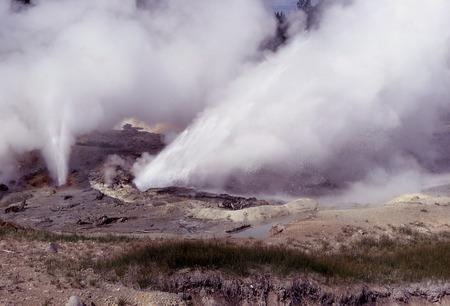Statistics can’t do justice to Yellowstone National Park, but numbers help to reveal some of its many facets.
$750,000,000
Estimated cost of the park’s deferred maintenance and infrastructure repairs as of 2009.
$345,267,000
Total visitor spending in 2008. At least 6,293 jobs in the park’s gateway region could be attributed to Yellowstone National Park visitor spending.
3,066,580
Recreational visits in 2008. The daily count peaked at around 27,000 in July.
2,219,790.71
Acreage of the park (includes 1.58 acres non-Federally owned).
1,194,187
Overnight stays in the park during 2008.
800,000
Estimated acres of park land burned in the 1988 wildfires.
640,000 (+/-)
Years since the last catastrophic eruption of the Yellowstone supervolcano.
$282,258
Approximate value of each of the park’s wolves to the three-state (WY/MT/ID) regional tourism industry, which records an estimated $35 million a year in “wolf tourism” benefits. At the end of 2008, the park’s wolf population stood at about 124 animals (in 12 packs).
10,000
Number of geothermal features such as hot springs, geysers, fumaroles, mud pots, and paint pots. This is about 75% of the geothermal features in the entire world.
$10,000
Amount that Congress allocated in 1878 to operate the park.
8,000
Number of gallons of water ejected in an Old Faithful Geyser eruption.
7,733
Elevation, in feet, of the surface of 136 square-mile Yellowstone Lake, America’s largest high-altitude lake.
4,300
The park’s peak work force, consisting of around 3,500 concessionaire employees and about 800 park employees (of which about 380 are year round employees).
2,900
Size of Yellowstone’s bison herd in early 2009 (down from 4,900 in 2005).
1,200
Estimated miles of trails in the park. Also, the approximate number of different species -- including some not previously known to inhabit the park – that scientists identified in a two square-mile area of the park during a one-day “bioblitz” species inventory conducted in August 2009.
720
Number of snowmobiles per day that were permitted in the park under terms of a 2004 temporary rule which the state of Wyoming wants reinstated. Currently, interim rules allow 318 snowmobiles and 78 snowcoaches to enter the park per day.
80+ %
Percentage of the park’s grizzly population that travels outside the park boundaries each fall to search for gut piles that elk hunters leave when they field-dress their kills. The Yellowstone Distinctive Population Segment consists of about 600 grizzlies that inhabit a 5.9 million-acre Primary Conservation Area which includes the park and about 4 million acres of surrounding land (mostly national forest).
50
Number of men in the construction crew that built Old Faithful Inn during a single winter, the unusually cold and snowy winter of 1903-1904.
41
Average temperature, in degrees Fahrenheit, of Yellowstone Lake water.
$25
Entrance fee for a private, noncommercial vehicle. It’s good for seven days, and you can use it at Grand Teton as well as Yellowstone).
0
Number of acres of the park’s wilderness included in the National Wilderness System. There is not now, nor has there ever been, any federally-designated wilderness in the park.




Comments
Thanks for all the interesting data, but I would like to offer one correction. Yellowstone Park is not home to 600 grizzlies. It's the park (roughly 2 million acres), plus about 4 million acres of mostly US Forest Service land surrounding the park that make up the 5.9 million acre "primary conservation area" for grizzlies. The estimated 600 grizzly bears live on that land, plus 10 miles beyond the boundary of the primary conservation area.
One of the primary reasons grizzly bears should not have been delisted and then ended up getting relisted, is that all the land outside the park where grizzlies live did not have adequate regulations in place to protect grizzlies and their habitat.
Yellowstone Park, I'm pleased to say, does a darn good job of protecting bears and their habitat. Most grizzly bear mortality occurs outside the park. The NPS does an excellent job of enforcing regulations that keep people from feeding grizzly bears unnatural foods. In contrast, the U.S. Forest Service does a mediocre job, and that's part of the reason so many grizzlies get killed outside the park.
[Thanks. The offending statement was replaced with one referring to the Yellowstone DPS grizzlies instead of the park grizzlies.That's a very important distinction. Ed.]